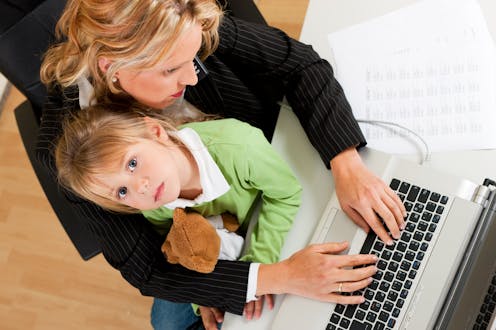Victoria's child-care shutdown is a hard blow for working mothers
- Written by Danielle Wood, Chief executive officer, Grattan Institute

How do you occupy a child for long enough to get any work done?
This will be the question confronting more than 150,000 Melbourne families for at least the next six weeks.
The Stage 4 restrictions announced by the Victorian government to contain the city’s COVID-19 outbreak include closing all child-care centres for the first time in the pandemic.
Read more: State of disaster called as Melbourne moves to nightly curfew and stage 4 restrictions
Only services for vulnerable children and children whose parents are deemed essential workers will continue.
This will have a big impact on workforce participation – particularly for mothers, who take on the lion’s share of unpaid care.
Child-care and workforce participation
The health advice is that these closures are needed to get Victoria’s COVID-19 outbreak under control. So the focus needs to be on what governments can do to cushion the impact on parents – and to support workforce participation on the other side.
Child-care is critical for women’s workforce participation. Its closure will have significant economic fallout. About 170,000 Melbourne children aged five and under are enrolled in formal early childhood education and care services. The average child in long day care attends for more than 25 hours a week.
The common backup plan for parents in lieu of professional child-minding services – grandparents – is not an option for many either, given health concerns and travel restrictions.
Most parents with young children don’t have much “slack”. On average, they do more than 80 hours a week of paid and unpaid work – the most of all adults.
It seems inevitable the only way many households will be able to manage their caring responsibilities is by reducing their paid work. This will be a financial hit not only for them but for the wider economy, further reducing spending and economic activity.
Women most affected
The closure of child-care centres will be especially tough on working mothers. Australian women still do the bulk of looking after children and housework.
A 2019 Deloitte analysis estimated the average Victorian woman spent 13 hours more on unpaid work and care a week than the average Victorian man. Men generally do more paid work, but this still doesn’t make up the full gap.
Deloitte’s findings are consistent with patterns Australia-wide, where the balance of paid and unpaid work in heterosexual couples is more gendered than almost anywhere else in the western world.
During the first lockdown, the unpaid workload increased for both women and men, but more for women.
Responses to an online Work and Care in the Time of COVID-19 survey between early May and June suggest women have more commonly borne the brunt of juggling work and children, including supervising online schooling.
These patterns indicate it will be women who are most likely to reduce their hours of paid work without school or day-care services available. This has already been seen overseas.
Any hit to women’s workforce participation – particularly if it becomes entrenched – will further widen the lifetime earnings gap between men and women. On pre-pandemic working patterns, the average 25-year-old woman who goes on to have at least one child could expect to earn 47% less than an average 25-year-old man who becomes a father.
Policy can help on the other side
The challenge for policymakers is to prevent this short-term economic pain becoming permanent.
The federal government has introduced temporary arrangements to enable Victorian parents to keep their child-care place through this lockdown. Providing income support for child-care workers who may be stood down during the shutdown is also important.
But these policies alone will not be sufficient to support female workforce participation when child-care reopens.
If governments are serious about reducing the fallout, we need to talk about making it more affordable on the other side.
Read more: Permanently raising the Child Care Subsidy is an economic opportunity too good to miss
Child-care costs are one of the biggest barriers to female workforce participation.
Raising the federal government’s Child Care Subsidy would help parents, particularly women, get back to work – supporting both the short-term economic recovery and growing the economy in the longer term.
Authors: Danielle Wood, Chief executive officer, Grattan Institute
Read more https://theconversation.com/victorias-child-care-shutdown-is-a-hard-blow-for-working-mothers-143837





